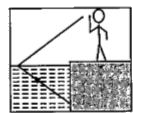Assertion :- Only the pigmented layer of the neuro sensory tunic continues along the ciliary body and the iris.
Reason:- Light rays cannot reach the ciliary body and back of iris to form an image.
If both assertion and reason are true and reason is the correct explanation of assertion.
If both assertion and reason are true but reason is not the correct explanation of assertion
If assertion is true but reason is false.
If both assertion and reason are false.
The correct Answer is:A
Step by step video, text & image solution for Assertion :- Only the pigmented layer of the neuro sensory tunic continues along the ciliary body and the iris. Reason:- Light rays cannot reach the ciliary body and back of iris to form an image. by Biology experts to help you in doubts & scoring excellent marks in Class 12 exams.
Topper's Solved these Questions
- BOOK - MOTIONCHAPTER - SENSORY ORGANSEXERCISE - EXERCISE - 27videos
SENSORY ORGANS
- BOOK - MOTIONCHAPTER - RESPIRATION IN PLANTS EXERCISE - EXERCISE - 419videos
RESPIRATION IN PLANTS
- BOOK - MOTIONCHAPTER - SEXUAL REPRODUCTION IN FLOWERING PLANTSEXERCISE - Exercise - 4(AIIMS-2018)25videos
SEXUAL REPRODUCTION IN FLOWERING PLANTS
Similar Questions
Assertion :- Accomodation is done by Iris of eye.
Reason:- Lens is biconcave and flexible in nature and ciliary body muscles does not help for this process.View SolutionAssertion:Choroid layer is thick over the posterior two-third of the eye ball but it becomes thin in the anterior part.
Reason:Choroid layer lacks blood vessels It forms ciliary body in the anterior part of the eye ball.View Solution
Knowledge Check
- Question 1 - Select One
Muscles of Iris & Ciliary body originate :−
AEctodermBMesodermCEndodernDAll of above - Question 2 - Select One
Assertion. Life history of Funaria is completed only when it is growing in humid conditions.
Reason. The plant body is very delicate and cannot withstand dry condition.AIf both Assertion and Reason are true and the Reason is a correct explanation of the Assertion.BIf both Assertion and Reason are true but Reason is not a correct explanation of the Assertion.CIf Assertion is true but the Reason is false.DIf both Assertion and Reason are false. - Question 3 - Select One
Negative Refractive Index:
One of the most fundamental phenomena in optics is refraction. When a beam of light crosses the interface between two different materials, its path is altered depending on the difference in the refractive indices of the materials. The greater the difference, the greater the refraction of the beam. For all known naturally occurring materials the refractive index assumes only positive values. But does this have to be the case?
In 1967, Soviet physicist Victor Veselago hypothesized that a material with a negative refractive index could exist without violating any of the laws of physics.
Veselago predicted that this remarkable material would exhibit a wide variety of new optical phenomena. However, until recently no one had found such a material and Veselago's ideas had remained untested. Recently, meta-material samples are being tested for negative refractive index. But the experiments show significant losses and this could be an intrinsic property of negative index materials.
Snell's law is satisfied for the material having a negative refractive index, but the direction of the refracted light ray is 'mirror-imaged about the normal to the surface.

There will be an interesting difference in image formation if a vessel is filled with "negative water" having refractive index - 1.33 instead of regular water having refractive index 1.33.
Say, there is a fish in a vessel filled with negative water. The position of the fish is such that the observer cannot see it due to normal refraction since the refracted ray does not reach to his eye.

But due to negative refraction, he will be able to see it since the refracted ray now reaches his eye.
A ray in incident on normal glass and. "Inegative glass" at an angle 60∘. If the magnitude of angle of refraction in normal glass is 45∘ then, what will be the magnitude of angle of refraction in the "negative glass"?ALess than 45∘BMore than 45∘C45∘DUnpredictable
Assertion : The equation of motion can be applied only if acceleration is along the direction of velocity and is constant.
Reason : If the acceleration of a body is constant then its motion is known as uniform motion.View SolutionAssertion : Ribs are thin, flat and curved bones that form a protective cage around some internal organs of the body.
Reason : All the 24 ribs are attached to the backbone at the back and to the breastbone in the front.View SolutionWhich of the following is correct for pupil of human eye ?
I it is the aperture surrounded by the iris.
II the diameter of pupil is regulated by muscle fibres of iiris
III it is a transparent crystalline structure attached to the ciliary body
The correct option isView SolutionI. Association areas, which are mainly motor in function, are responsible for functions like intersensory associations, memory, and communication.
II. Midbrain and hindbrain forms the brain stem.
III. The ciliary body itself continues forward to form a pigmented and opaque structure- iris.
IV. The membranous labyrinth is filled with a fluid called endolymph.
How many of the given statements are correct?View SolutionAssertion: If a body moves on a straight line, magnitude of its displacement and distance covered by it will be same.
Reason: Along the straight line body can move only in one direction.View Solution
